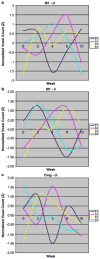Ankle dorsiflexion as an fMRI paradigm to assay motor control for walking during rehabilitation
- PMID: 15325385
- PMCID: PMC4164211
- DOI: 10.1016/j.neuroimage.2004.06.008
Ankle dorsiflexion as an fMRI paradigm to assay motor control for walking during rehabilitation
Abstract
The ability to walk independently with the velocity and endurance that permit home and community activities is a highly regarded goal for neurological rehabilitation after stroke. This pilot study explored a functional magnetic resonance imaging (fMRI) activation paradigm for its ability to reflect phases of motor learning over the course of locomotor rehabilitation-mediated functional gains. Ankle dorsiflexion is an important kinematic aspect of the swing and initial stance phase of the gait cycle. The motor control of dorsiflexion depends in part on descending input from primary motor cortex. Thus, an fMRI activation paradigm using voluntary ankle dorsiflexion has face validity for the serial study of walking-related interventions. Healthy control subjects consistently engaged contralateral primary sensorimotor cortex (S1M1), supplementary motor area (SMA), premotor (PM) and cingulate motor (CMA) cortices, and ipsilateral cerebellum. Four adults with chronic hemiparetic stroke evolved practice-induced representational plasticity associated with gains in speed, endurance, motor control, and kinematics for walking. For example, an initial increase in activation within the thoracolumbar muscle representation of S1M1 in these subjects was followed by more focused activity toward the foot representation with additional pulses of training. Contralateral CMA and the secondary sensory area also reflected change with practice and gains. We demonstrate that the supraspinal sensorimotor network for the neural control of walking can be assessed indirectly by ankle dorsiflexion. The ankle paradigm may serve as an ongoing physiological assay of the optimal type, duration, and intensity of rehabilitative gait training.
Figures




References
-
- Baer G, Smith M. The recovery of walking ability and subclassification of stroke. Physiother Res Int. 2001;6:135–144. - PubMed
-
- Barbeau H. Locomotor training in neurorehabilitation: emerging rehabilitation concepts. Neurorehabilitation Neural Repair. 2003;17:3–11. - PubMed
-
- Bawa P, Chalmers G, Stewart H, Eisen A. Responses of ankle extensor and flexor motoneurons to transcranial magnetic stimulation. J Neurophysiol. 2002;88:124–132. - PubMed
-
- Boroojerdi B, Ziemann U, Chen R, Butefisch C, Cohen L. Mechanisms underlying human motor system plasticity. Muscle Nerve. 2001;24:602–613. - PubMed
Publication types
MeSH terms
Grants and funding
LinkOut - more resources
Full Text Sources
Medical

